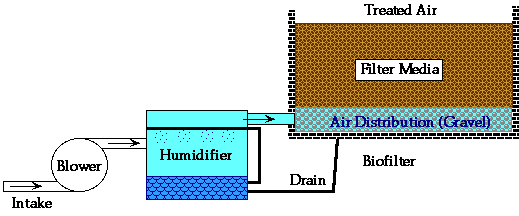
Odor control is one of the primary concerns of large scale composting facilities, especially those located near residential areas. While good process management and careful housekeeping can greatly reduce odors, in many cases some method of odor treatment will still be required. There are several options for odor treatment, including chemical stripping, thermal destruction, and biofiltration. In many cases biofiltration is both the least expensive and most effective treatment option, which has led to its widespread use in the composting industry today.
Biofiltration
A biofilter uses moist organic materials to adsorb and then biologically degrade odorous compounds. Cooled and humidified compost process air is typically injected through a grid of perforated pipes into a bed of filtration media. The materials that have been used for biofilter construction include compost, soil, peat, chipped brush and bark, sometimes blended with a biologically inert material such as gravel to maintain adequate porosity. Biofilter bed depths typically range from 1 to 1.5 meters deep, with shallower beds subject to short-circuiting of gas flow and deeper beds more difficult to keep uniformly moist. Biofilters have been shown to be effective at treating essentially all of the odors associated with composting, including ammonia and a wide range of volatile organic compounds (including sulfur compounds and amines).
The principle design criteria is the airflow rate per unit surface area of the biofilter. Literature values for biofilter airflows range from 0.005 to 0.0025 m/s (1 to 5 cfm/ft²) and are typically 0.015 to 0.02 m/s (3 to 4 cfm/ft²). For the purpose of selecting the biofilter blower, the backpressure expected across the biofilter at this airflow rate is usually in the range of 20 to 120 mm H2O/m depth (0.22 to 0.9 inches H2O/ft), although the pressure drop can be considerably higher through dense composts and soil.
For soil filters, standard specifications are (in SI units, from Skoda, 1991):
Unsaturated air coming out of the compost building will dry the biofilter and rewetting from the surface is generally not uniform. A simple humidification scheme is illustrated in the schematic diagram below.
Biofilter Schematic:

References:
Haug, R.T. 1993. The Practical Handbook of Compost Engineering.
Lewis Publishing, Boca Raton, FL.
Lesson, G. and K.A.M. Winer. 1991. Biofiltration: An innovative
air pollution control technology for VOC emissions. J. Air Waste
Mgt. Assoc., 41(8):1045-1054.
Shoda, M. 1991. Methods for the biological treatment of exhaust
gases. In: Biological Degradation of Wastes. A.M. Martin (ed.)
Elsevier Applied Science, London. pp. 1-30.
Williams, T.O. and F.C. Miller. 1992. Odor control using biofilters.
BioCycle 33(10):72-77.
Williams, T.O. and F.C. Miller. 1992. Biofilters and facility
operations. BioCycle 33(11):75-79.
|
Composting |
Engineering |
in Schools |
|
Cornell Waste Management Institute ©1996
Cornell University
Ithaca, NY
607-255-1187
cwmi@cornell.edu